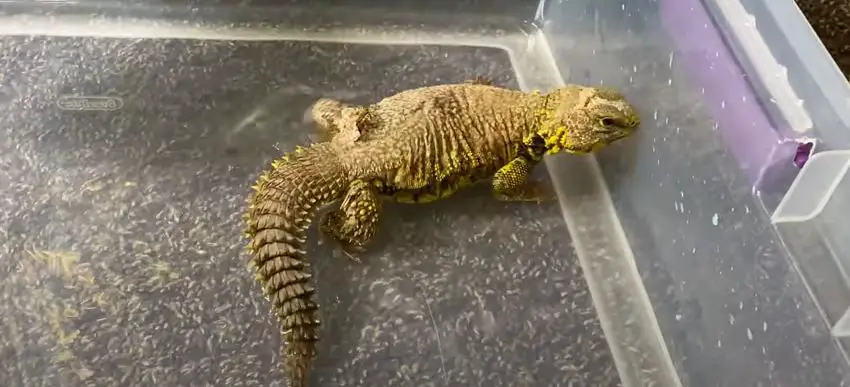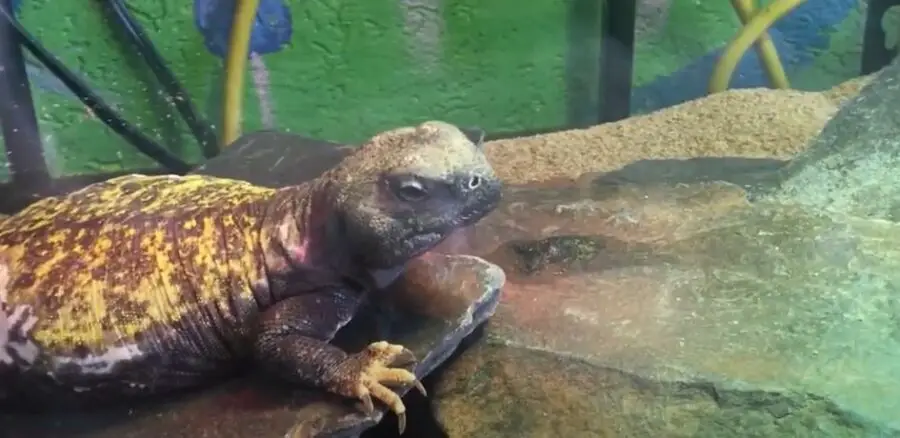It’s so easy to assume that all pets need water. Do Uromastyx need water? Is this a silly question or one that requires more thinking and strategy?
How do you hydrate uromastyx? Do uromastyx like to get wet? Should I mist their enclosure?
In this article, you will be able to find out what you need to do and should not do to hydrate a uromastyx as you find out, “Do Uromastyx Need Water?”
Do Uromastyx Need Water ?
Water is life; even for the uromastyx. Water will be acquired from their various food sources such as dark leafy greens or fruits.
You can offer clean drinking water, but be informed that even if your uromastyx doesn’t drink from it, they can hydrate themselves from their diet if you make sure they eat juicier fruits and vegetables.
You can spray their meals with water to add more moisture. Leaving a water source in their enclosure at all times raises humidity levels which could lead to respiratory problems in their future.

Do I Need To Give Uromastyx Water?
You are not forced to provide a dish or bowl of water for a uromastyx in their cage. They usually do not drink water from a water receptacle, dispenser or bottle.
Make sure their diet consists of fruits and vegetables that contain plenty of moisture within. If your uromastyx primarily survives on seeds and pellets, they will need a water source available to them as these food are too dry and don’t contain much moisture at all.
You can soak seeds or sprout them as well. Hard or chalky stool means that your uromastyx would benefit from more moisture rich foods or water to prevent dehydration.
What does temperature and humidity have to do with water requirements? I’ll help explain that in this separate article.
How Do You Give Uromastyx Water?
I make sure the water I give my uromastyx is dechlorinated and filtered. Tap water doesn’t cut it for a animal that is only going to drink a small amount anyways.
This is why place the water on a mayonnaise jar instead of a bowl or larger dish. You can use a petri dish or the lid of any other jar. I keep the water at room temperature because when it is too cold or too hot, my uromastyx wants nothing to do with it.
Overall, the best way to give water to a uromastyx is through the food they are served.
Fruits and dark leafy greens carry enough moisture for a uromastyx to hydrate themselves in most cases where enclosures are kept at the right temperature. You can also spray these foods to add more water on top.
I also need to explain what seeds can uromastyx eat in conjunction with water. This is important info to share.

Why A Uromastyx Doesn’t Need Water
We are caring for a spiny tailed lizard who comes from very dry climates. The humidity in the desert-like conditions where a uromastyx originates is around 10-25%.
Do you need to mist a uromastyx? In my opinion, getting a uromastyx wet and misting the enclosure to increase humidity is not recommended or needed for a dry lizard like a Uro.
If you want to add water to their diet without actually giving them water, spray their veggies or fruits servings with water. If you wish to feed a uromastyx a live insect like a cricket (not necessary to feed them insects) you can hydrate them first.
The easiest way for me is to just keep a spray bottle of purified water on hand and give one pump on a dark leafy green before offering it to my lizard companion.
How will this affect their appetite for seeds? See why this topic needs to be addressed.
Can a Uromastyx Get Wet?
A Uromastyx will become stressed in water. If the water is very shallow and only get their limbs wet or belly at most, they will be able to get themselves out without too much stress.
Some lizards will take to a water soak or wet cloth for spot cleaning while others will shy away or let you know that they do not want to get wet.
Water adds to humidity and creates respiratory problems for an extremely dry climate loving animal like a uromastyx.
Will it affect their temperament as well? I’ll explain that here.

No Water Bowls of Misting For Uromastyx
Keeping Uromastyx in water or adding too much moisture in their enclosure will raise humidity levels. The substrate may contain some moisture, but overall, there should be no misting of the enclosure.
Excess water creates respiratory problems and damages their kidney function. Adding a bowl of water in their tank will also cause it to evaporate some and spread more moisture around as well for a sensitive animal who demands dry conditions.
I keep the humidity lower at 10-40% maximum in order to not stress my spiny tailed lizard who may develop breathing problems as a result.
Will they need changes to their enclosure when they brumate? You will need to check for this here.
How Do I Know If My Uromastyx Is Hydrated?
If your uromastyx is well hydrated, they will be able to tell you in one easy way. Check their stool. Their poop should not be too hard, dry or chalky.
A lot of evidence on pet health is based on checking the consistency and normal look of their feces. Check for these conditions as well to indicate that your uromastyx is hydrated:
- Skin doesn’t sag
- Eyes not sunken
- Mainly White solid urates excreted (not yellow or orange)
- Not lethargic
- Eats leafy greens and fruits
Conclusion
Uromastyx evolved to retain water. They are hydrated through the food they eat. Uromastyx does not wish to be bathed or cleaned off. They will shed their skin and become cleaner this way.
Add foods like grapes and romaine lettuce for plenty of water hydration. You can mist or spray water on any foods you’re offering as well.
The substrate can be deep to encourage digging and offering spaces for moisture. Otherwise, the rest of the tank can be dry and doesn’t require misting or raising humidity levels.
I cap humidity at 25%, but you can go as high as 40% before the moisture in the air starts to affect their breathing.
Thank you for visiting PocketPetCentral.com for the best information to help you enjoy the life of your pocket pet companion in a fun, safe & healthy way.

